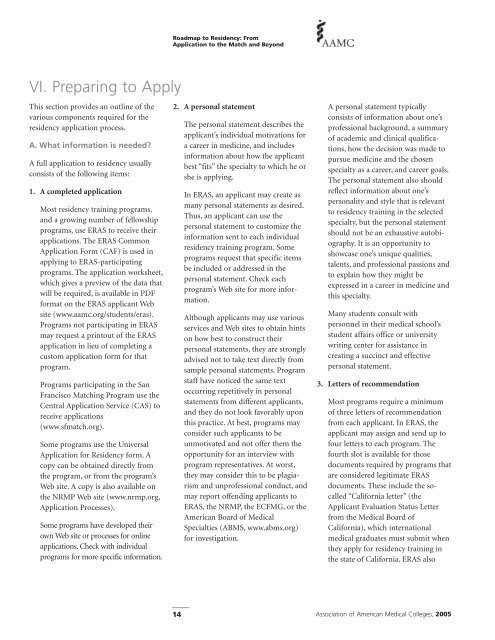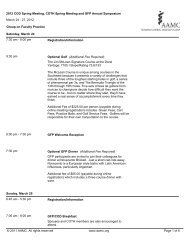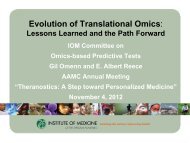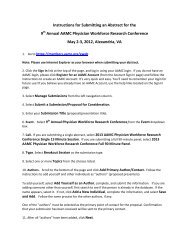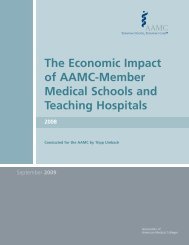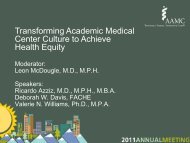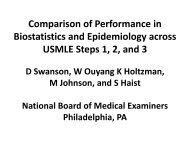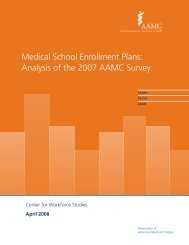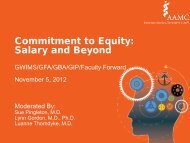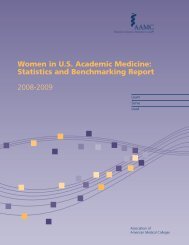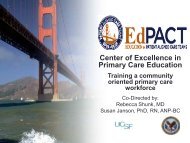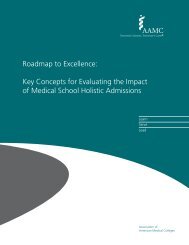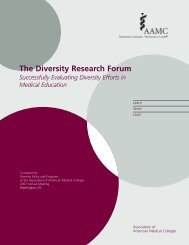Roadmap to Residency: - AAMC
Roadmap to Residency: - AAMC
Roadmap to Residency: - AAMC
You also want an ePaper? Increase the reach of your titles
YUMPU automatically turns print PDFs into web optimized ePapers that Google loves.
<strong>Roadmap</strong> <strong>to</strong> <strong>Residency</strong>: FromApplication <strong>to</strong> the Match and BeyondVI. Preparing <strong>to</strong> ApplyThis section provides an outline of thevarious components required for theresidency application process.A. What information is needed?A full application <strong>to</strong> residency usuallyconsists of the following items:1. A completed applicationMost residency training programs,and a growing number of fellowshipprograms, use ERAS <strong>to</strong> receive theirapplications. The ERAS CommonApplication Form (CAF) is used inapplying <strong>to</strong> ERAS-participatingprograms. The application worksheet,which gives a preview of the data thatwill be required, is available in PDFformat on the ERAS applicant Website (www.aamc.org/students/eras).Programs not participating in ERASmay request a prin<strong>to</strong>ut of the ERASapplication in lieu of completing acus<strong>to</strong>m application form for thatprogram.Programs participating in the SanFrancisco Matching Program use theCentral Application Service (CAS) <strong>to</strong>receive applications(www.sfmatch.org).Some programs use the UniversalApplication for <strong>Residency</strong> form. Acopy can be obtained directly fromthe program, or from the program’sWeb site. A copy is also available onthe NRMP Web site (www.nrmp.org,Application Processes).Some programs have developed theirown Web site or processes for onlineapplications. Check with individualprograms for more specific information.2. A personal statementThe personal statement describes theapplicant’s individual motivations fora career in medicine, and includesinformation about how the applicantbest “fits” the specialty <strong>to</strong> which he orshe is applying.In ERAS, an applicant may create asmany personal statements as desired.Thus, an applicant can use thepersonal statement <strong>to</strong> cus<strong>to</strong>mize theinformation sent <strong>to</strong> each individualresidency training program. Someprograms request that specific itemsbe included or addressed in thepersonal statement. Check eachprogram’s Web site for more information.Although applicants may use variousservices and Web sites <strong>to</strong> obtain hintson how best <strong>to</strong> construct theirpersonal statements, they are stronglyadvised not <strong>to</strong> take text directly fromsample personal statements. Programstaff have noticed the same tex<strong>to</strong>ccurring repetitively in personalstatements from different applicants,and they do not look favorably uponthis practice. At best, programs mayconsider such applicants <strong>to</strong> beunmotivated and not offer them theopportunity for an interview withprogram representatives. At worst,they may consider this <strong>to</strong> be plagiarismand unprofessional conduct, andmay report offending applicants <strong>to</strong>ERAS, the NRMP, the ECFMG, or theAmerican Board of MedicalSpecialties (ABMS, www.abms.org)for investigation.A personal statement typicallyconsists of information about one’sprofessional background, a summaryof academic and clinical qualifications,how the decision was made <strong>to</strong>pursue medicine and the chosenspecialty as a career, and career goals.The personal statement also shouldreflect information about one’spersonality and style that is relevant<strong>to</strong> residency training in the selectedspecialty, but the personal statementshould not be an exhaustive au<strong>to</strong>biography.It is an opportunity <strong>to</strong>showcase one’s unique qualities,talents, and professional passions and<strong>to</strong> explain how they might beexpressed in a career in medicine andthis specialty.Many students consult withpersonnel in their medical school’sstudent affairs office or universitywriting center for assistance increating a succinct and effectivepersonal statement.3. Letters of recommendationMost programs require a minimumof three letters of recommendationfrom each applicant. In ERAS, theapplicant may assign and send up <strong>to</strong>four letters <strong>to</strong> each program. Thefourth slot is available for thosedocuments required by programs thatare considered legitimate ERASdocuments. These include the socalled“California letter” (theApplicant Evaluation Status Letterfrom the Medical Board ofCalifornia), which internationalmedical graduates must submit whenthey apply for residency training inthe state of California. ERAS also14Association of American Medical Colleges, 2005


